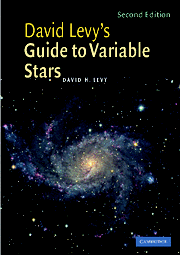Book contents
- Frontmatter
- Contents
- Foreword to the first edition
- Preface
- Acknowledgments
- Part I Getting to know the sky
- Part II Getting to know the variables
- 5 Meeting the family
- 6 Getting started with Cepheids
- 7 Algol, the demon of autumn
- 8 How to estimate a variable
- 9 Names and records
- 10 How your observations help us understand a variable star
- 11 Observing hints
- 12 Observing with CCDs
- 13 Stately and wonderful
- 14 Stars of challenge
- 15 Bright, easy, and interesting
- 16 Betelgeuse: easy and hard
- 17 Not too regular
- 18 Nova? What nova?
- 19 Supernovae
- 20 Clyde Tombaugh's star and the family of cataclysmic variables
- 21 A nova in reverse?
- 22 RU Lupi?
- 23 Orion, the star factory
- 24 Other variable things
- 25 The Sun
- Part III Suggested variables for observation throughout the year
- Part IV A miscellany
- Index
13 - Stately and wonderful
from Part II - Getting to know the variables
Published online by Cambridge University Press: 05 August 2012
- Frontmatter
- Contents
- Foreword to the first edition
- Preface
- Acknowledgments
- Part I Getting to know the sky
- Part II Getting to know the variables
- 5 Meeting the family
- 6 Getting started with Cepheids
- 7 Algol, the demon of autumn
- 8 How to estimate a variable
- 9 Names and records
- 10 How your observations help us understand a variable star
- 11 Observing hints
- 12 Observing with CCDs
- 13 Stately and wonderful
- 14 Stars of challenge
- 15 Bright, easy, and interesting
- 16 Betelgeuse: easy and hard
- 17 Not too regular
- 18 Nova? What nova?
- 19 Supernovae
- 20 Clyde Tombaugh's star and the family of cataclysmic variables
- 21 A nova in reverse?
- 22 RU Lupi?
- 23 Orion, the star factory
- 24 Other variable things
- 25 The Sun
- Part III Suggested variables for observation throughout the year
- Part IV A miscellany
- Index
Summary
R Leonis
On a bitter January night in frosty Montreal, I first watched R Leonis. A cold front had just passed through, leaving a crisp starry sky. Checking my variable-star chart, I began to look for R. It was frightfully cold. After an uncomfortable 45-minute search I finally found R Leonis as it rose through the haze and smog that hugged the eastern horizon. By this time I was so cold that even the simplest and smallest motions of the telescope were magnified into an agonizing exercise that taxed my whole being. I had finally found a faint magnitude 9.3 star, graced by two other stars – chambermaids assisting a stellar queen – at 9.1 and 9.6. It was so cold that the telescope tube froze to its mount and I couldn't even take the poor instrument inside! Quickly, observer minus telescope moved inside for some warmth. Never had hot chocolate tasted so good!
Still outside, hundreds of light years away, shone my new variable. On that frigid night, R Leonis taught me two important lessons. One was that variable star observing can be challenging and worthwhile. The other is that to observe variables properly, one must first acquire a feeling for them, a genuine concern for what they are doing, and a will to undergo some discomfort to remain in touch with them. You may not feel this the first cold night out, but you will as you get familiar with the variable's behavior.
- Type
- Chapter
- Information
- David Levy's Guide to Variable Stars , pp. 68 - 76Publisher: Cambridge University PressPrint publication year: 2005

